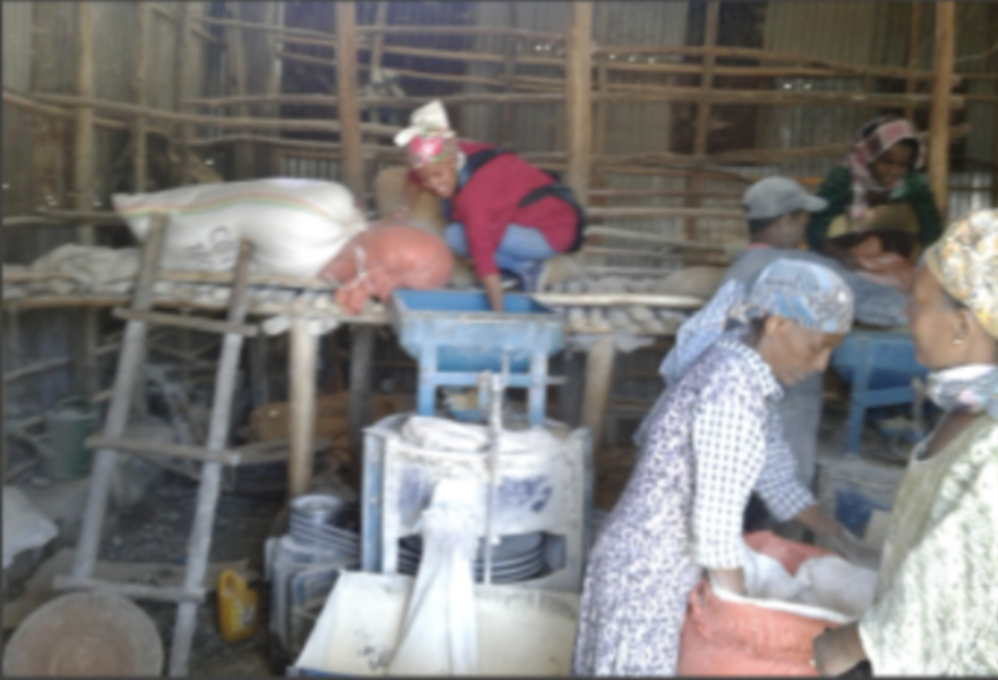
Under nutrition is a major public health problem among children in Ethiopia causing irreversible consequences on children’s physical and mental health and contributes to over half of child deaths. School- age children face high levels of illness and malnutrition during their crucial growing years, decreasing their ability to pay attention and progress in school. Reports indicate that school children can lose as much as 160 days each year due to illness because under nutrition magnifies the effect of every disease (FAO, 2012).
Despite the importance of school meals for vulnerable and poor children, currently only 5% of primary school age children are beneficiaries of a School Feeding Program (SFP) in Ethiopia. School feeding programs use two main ways to distribute : on-site meals and take-home rations. In the past IFA served on-site meals to vulnerable school children at five public schools . Currently provides the take-home rations (THR) method at Jihur Primary school which serves both the town dwellers of Jihur and the nearby rural community.


Take Home Ration at Jihur Primary School
IFA is distributing Take Home Rations for rural school children in Jihur Primary school located in Norther Shewa of Amhara Region where chronic malnutrition and stunting is high. School meals may not target the underlying causes of malnutrition and food security, but they have many benefits.
as
Definition of School Feeding
"Targeted social safety nets that provide both educational and health benefits to the most vulnerable children, thereby increasing enrollment rates, reducing absenteeism, and improving food security at the household level". World Bank

Each month, IFA prepares a 10kg multigrain mix for each child. The families are instructed in how they can prepare various meals that are compatible with the cultural eating habits of Jihur by using the multigrain mix to make porridges and pita bread type flatbread (called “kitta” in Ethiopia)
124 primary school vulnerable students, of which 58 are girls and 66 are boys from 92 households, receive the cereal-mix donation every month.
The monthly take-home ration (THR) has several benefits:
- It is shared with the whole family – Targeted take-home rations increase the nutrition of the family, and not just family members that are of primary-school age
- It is in line with what is called “home-grown school feeding,” where the food provided is produced and purchased within the country, thus allowing smallholder farmers to benefit from access to a market with stable, structured, and predictable demand
- It links agriculture, nutrition, and education
Linking school feeding with small-holder agriculture has a three-pronged effect (Masset, Edoardo and Aulo Gelli. (2013):
- Food security: supporting incomes of recipient households (those consuming food) and farmer households (those providing the food)
- Education: increasing school enrolment, attendance and reducing drop-out, and improving cognition and learning achievement
- Health: improving nutritional status of school age children
In countries like Ethiopia, where the prevalence of undernutrition and stunting is high, helping families feed all its members is important, regardless of whether they are in school or not.
Take Home Ration is a good distribution systems
A recent opinion survey of the THR done at Jihur Primary School revealed that 96% of the parents and 60% of the students favor the THR more than the school meals.

Take Home Ration at Jihur Primary School
IFA is distributing Take Home Rations for rural school children in Jihur Primary school located in Norther Shewa of Amhara Region where chronic malnutrition and stunting is high. School meals may not target the underlying causes of malnutrition and food security, but they have many benefits.
Geographic Focus and Target Groups:
- Agazi Primary School (APS); Woreda 08; Nefas Silk Lafto Sub City
- Lafto Primary School (LPS); Woreda 12; Nefas Silk Lafto Sub City
- Hana Primary School (HPS); Woreda 01; Nefas Silk Lafto Sub City
Project Objectives and Results:
- Reduced hunger.
- Increased school enrollment.
- Improved attendance, concentration, learning, and school activity.
- Increased progression between grades.
- Improved health and wellbeing.
- Develop healthy eating habits.
- Reduced mood swings and depression.
Project Strategy:
The school meals project facilitates participation of multiple stakeholders and builds partnerships and leverage for educational outcomes and wellbeing among vulnerable children in public primary schools. We encourage participation of school administrators, teachers, and students in our day-to-day meals provision service. Teachers and elected students monitor breakfast and lunch meals service.
Main Project Activity Components:
- Prepare or install kitchen and dining area.
- Purchase kitchen and dining equipment.
- Providing fresh and nutritious breakfast and lunch during school days.
- Purchasing food supplies.
- Training of cooks on hygienic food handling and preparation.
- Monitoring and Supervision.
- Biannual deworming.
- Micronutrient supplementation.
